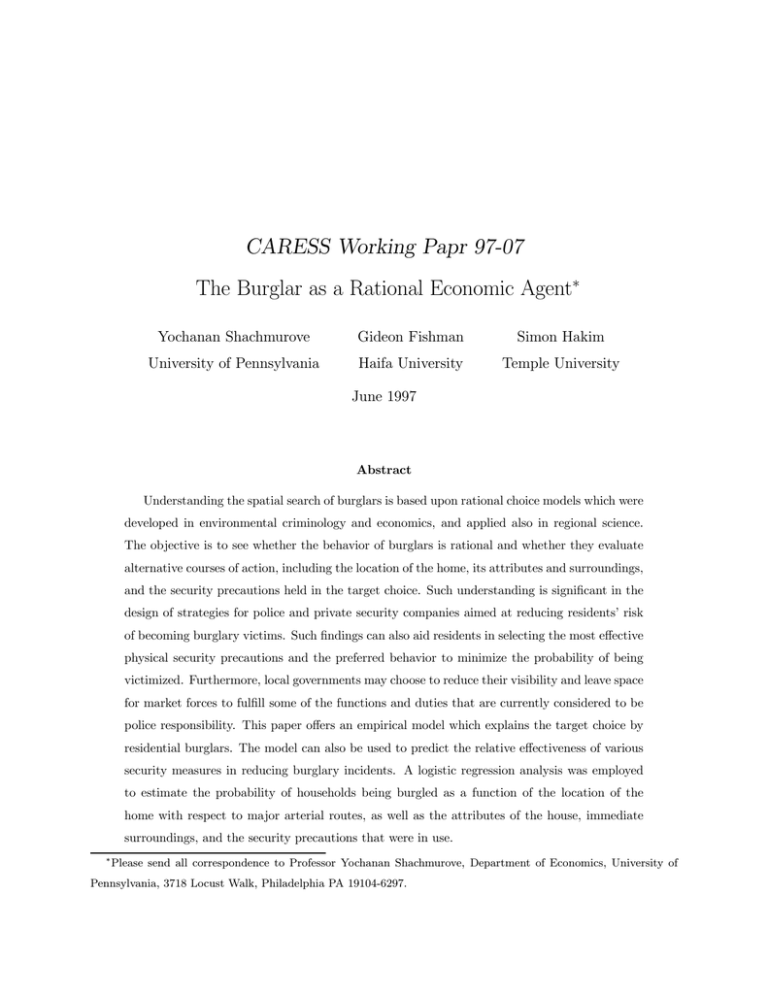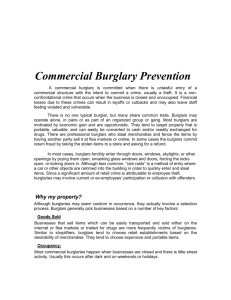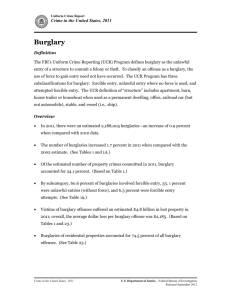CARESS Working Papr 97-07 The Burglar as a Rational Economic Agent
advertisement

CARESS Working Papr 97-07
The Burglar as a Rational Economic Agent¤
Yochanan Shachmurove
Gideon Fishman
Simon Hakim
University of Pennsylvania
Haifa University
Temple University
June 1997
Abstract
Understanding the spatial search of burglars is based upon rational choice models which were
developed in environmental criminology and economics, and applied also in regional science.
The objective is to see whether the behavior of burglars is rational and whether they evaluate
alternative courses of action, including the location of the home, its attributes and surroundings,
and the security precautions held in the target choice. Such understanding is signi¯cant in the
design of strategies for police and private security companies aimed at reducing residents' risk
of becoming burglary victims. Such ¯ndings can also aid residents in selecting the most e®ective
physical security precautions and the preferred behavior to minimize the probability of being
victimized. Furthermore, local governments may choose to reduce their visibility and leave space
for market forces to ful¯ll some of the functions and duties that are currently considered to be
police responsibility. This paper o®ers an empirical model which explains the target choice by
residential burglars. The model can also be used to predict the relative e®ectiveness of various
security measures in reducing burglary incidents. A logistic regression analysis was employed
to estimate the probability of households being burgled as a function of the location of the
home with respect to major arterial routes, as well as the attributes of the house, immediate
surroundings, and the security precautions that were in use.
¤
Please send all correspondence to Professor Yochanan Shachmurove, Department of Economics, University of
Pennsylvania, 3718 Locust Walk, Philadelphia PA 19104-6297.
1. Introduction
Understanding the spatial search of burglars is based upon rational choice models which were developed in environmental criminology and economics, and applied also in regional science. The
objective is to see whether the behavior of burglars is rational and whether they evaluate alternative courses of action, including the location of the home, its attributes and surroundings, and the
security precautions held in the target choice. Such understanding is signi¯cant in the design of
strategies for police and private security companies aimed at reducing residents' risk of becoming
burglary victims. Such ¯ndings can also aid residents in selecting the most e®ective physical security
precautions and the preferred behavior to minimize the probability of being victimized. Furthermore, local governments may choose to reduce their visibility and leave space for market forces to
ful¯ll some of the functions and duties that are currently considered to be police responsibility.
This paper o®ers an empirical model which explains the target choice by residential burglars.
The model can also be used to predict the relative e®ectiveness of various security measures in
reducing burglary incidents.
The deterrence hypothesis deals with the relative e®ectiveness of criminal justice activities
such as policing, sentencing, and applying corrective measures. This article concentrates on a
di®erent dimension of deterrence; namely, activities initiated by home owners aimed at reducing
the probability of becoming burglary victims. The paper presents the results of a logistic regression
analysis done on individual households where the probability of residential burglary is calculated
taking into account the location, surroundings, and attributes of the homes, as well as a variety
of security precautionary measures. The article suggests a package of e®ective measures for most
common attributes of homes.
The data base for this study is a detailed survey of all 22,192 households in Greenwich, Connecticut, of which 3,014 responded. The study reveals the properties of the deterrence hypothesis
and the rational behavior of burglars. The results may have policy implication for the police,
security companies, and home owners.
Section 2 discusses previous research results which explain the target choice of burglars. Section
3 presents the objectives of the study and its contribution to understanding the burglar's behavior.
2
In section 4 the characteristics of the surveyed community and the survey are introduced. Section
5 exhibits the results of the logistic regression estimation, and o®ers the probability of burglary for
prototype homes. Section 6 summarizes and discusses the major ¯ndings.
2. Literature Review
Becker, the 1992 Nobel Prize Laureate, published his seminal work on the rational behavior of the
criminal (1968), in which he claims that a criminal evaluates costs and bene¯ts in choosing his life
style and also in deciding whether to carry out a particular crime. Bene¯ts include both monetary
and psychological rewards, while costs include direct expenditures as well as the opportunity costs
of the burglar's time.
Hakim (1980) elaborated on Becker's model by introducing the space dimension. Accordingly,
the burglar's choice of a particular home depends on the expected net return of each potentially
available home, and that also includes the actual search cost.
Many seem skeptical as to whether burglars actually conduct rational search and choice. No
burglar has ever claimed to calculate the net return of the planned burglary and, accordingly, to
select the target with the highest value. However, it appears that burglars do implicitly evaluate
alternative actions without consciously and accurately calculating the net return for each act of
burglary. Research results persistently demonstrate that when a large number of burglaries are
statistically analyzed, they indeed reveal a maximization of net pro¯ts by burglars. Criminals
appear to implicitly consider a set of variables similar to those of researchers who explicitly calculate
the net bene¯ts of crime.
To validate these statistical ¯ndings, derived by large-sample cross-sectional studies, case studies
must be examined. While multivariate analysis primarily provides signi¯cant statistical association,
the case-study methodology can lend stronger support, beyond the correlational level, to cause-ande®ect relationships.
The National Institute of Justice, which is the research arm of the U.S. Department of Justice, commissioned in the early 1990s several ethnographic studies where burglars were interviewed,
followed, and then questioned about the process by which they searched out and chose their tar-
3
gets. The most notable ethnographic studies are those of Wright and Decker (1994), Rengert and
Wasilchick (1985, 1994), Cromwell et al. (1991), and Tunnell (1992). A sequential decision process
of target by burglars seems to prevail.
Burglars choose to operate along \familiarity routes,\ which they often use while traveling for
work or social purposes. By operating in a familiar area, they minimize the risk of facing unknowns.
They make sure that in case of need, they will have a safe escape route and be able to blend into
tra±c. (Rengert 1985, Chapt. 2).
Next, the residential burglar selects a middle or high income neighborhood, preferably of detached family homes. Burglars seem to be attracted to neighborhoods located within three blocks
(a quarter of a mile) of the major arterial route. These are areas where the expected loot is high
and the getaway relatively simple. It seems that burglars choose neighborhoods which ¯t well
with their inspiration zone. As one burglar put it: \I know what I can do there\ (Rengert and
Wasilchick, 1994: chapter 4).
Once a neighborhood is chosen, the burglar selects a quiet residential street where the chance
of being noticed while entering/exiting the premises is low. The burglar prefers a quiet residential street. A mixed commercial-residential street is less attractive due to the higher volume of
pedestrians and motor tra±c which raises the probability of being noticed breaking into the house.
Once on the street, the burglar scouts the speci¯c target. Now, he/she simultaneously considers
various factors: the value of the home, whether it is attended, its surroundings, and whether
access is concealed. The ethnographic studies revealed that burglars use all ¯ve senses in their
target selection. The most important factor, by all accounts, in residential target selection is
occupancy. Burglars look very carefully for clues that no one is in the house (Wright and Decker,
1994: 96, Cromwell et al., 1991: 24-26). Twenty-eight of thirty burglars stated that they would
never purposely enter an occupied residence (Cromwell et al., 1991: 37).
The second consideration of burglars is visibility: to approach the premises and break in with
little chance of being noticed. The actual illegal entry to most houses is easy and takes on average
sixty seconds. Variables which are indicators of visibility include the distance of the house from
the street or neighboring homes, woods surrounding the house, and bushes concealing access to
the house (Wright and Decker, 1994: 97, Cromwell et al., 1991: 35). Not surprisingly, a secluded
4
location of houses increases their probability of being burglarized.
Interestingly, ethnographic studies reveal that once a burglar locks in on the target and is
convinced that no one is there, little can be done to stop him/her from actually penetrating the
premises. Burglars are often habitual drug users: one third of those who reported at least six
burglaries a year indicated that their primary motivation was to get enough funds to purchase
drugs or alcohol. Studies suggest that most burglars use drugs before breaking into a house in
order to reduce anxiety and numb their fear (Figgie, 1988, Tunnell, 1992: 74). Thus, burglars
pursue their decision to enter the house while situational factors such as window decals which
are not easily noticeable from the street, or the presence of dead bolts, have low deterrence value
(Wright and Decker, 1994: 95). Conventional preventive measures do not reduce the probability of
burglary since the burglar always has alternative points of entry.
3. Objectives of the Study
This study tests whether a burglar follows a sequence of decisions in choosing a target. The
primary issue is whether a burglar is rational in his/her considerations and operates in a manner
that maximizes the net bene¯ts from each burglary. Obviously, the sequence of decisions does
not necessarily represent all burglars. The question is whether a large number of observations
provide statistically signi¯cant evidence that indeed the following ¯ve factors a®ect the incidence
of burglary. We are unable to prove from ex-post observation of a cross-sectional sample whether
such a sequential process actually exists. However, if in the regression analysis used to account
for burglary incidents, the ¯ve decision stages are statistically signi¯cant, this may suggest the
sequence of a decision process.
1. Burglars operate within a three-block corridor of familiar routes where they often travel for
work or social purposes.
2. Burglars choose a relatively a²uent community.
3. They choose a quiet, residential street.
4. Burglars choose a relatively wealthy home on the street which suggests a lucrative haul.
5. Burglars choose a target which is unoccupied, provides for concealed access, and a®ords easy
5
escape possibilities.
Clearly, only detailed examination of a large number of actual instances of burglars' spatial
target choice can con¯rm whether such a sequential model indeed exists. Case studies of individual
cases are needed to con¯rm cross sectional results and suggest a sequential decision process by
burglars. Ethnographic studies where small number of active burlars were Interviewed and followed up of a small number of active burglars cannot provide genelalized conclusions on the entire
population of burglars. Intentions expressed by burglars do not necessarily materialize in their
real behavior. Burglars may behave di®erently from their expressed intentions during simulated
conditions. However, implications concerning burglars' behavior are strengthened if similar results
are derived from a cross sectional data of burgled (non) homes and in Ethnographic studies.
Hakim (1980) distinguished between two crime models, Crime Generation and Crime Attraction. The Crime Generation Model refers to a situation where the crime rate is accounted for by
the attributes of the population where the criminals reside. The model assumes that most crimes
are produced by criminals who both reside and commit the crime within self-contained large geographical area like a metropolitan area. Methodologically, socio-economic attributes explain the
incidents of crime in the same geographic unit. On the other hand, the Crime Attraction Model
applies to situations where burglary is committed in a²uent suburban communities where most
burglars are non-residents, and crime is imported to the community. Such a model, in order to explain the probability of burglary, requires looking at the attributes of homes and businesses which,
according to the model, attract non-resident burglars. The individual socioeconomic attributes of
the residents, as such, are of no interest in this case since they do not explain the rate of burglary
in the community, as most burglars are from other communities. This study falls within the realm
of the second model.
Understanding the conditions under which the burglars act might indicate the most e®ective
measures for reducing the probability of burglary. For example, Cromwell et al. (1991) and Wright
and Decker (1994) claim that occupancy is the most important consideration for burglars when
looking for target choice. Both studies suggest that once a target is selected, the burglar vigorously
pursues his/her goal and does not stop even if the actual entry seems to be di±cult. If these ¯ndings
are supported, then deterrent measures are more e®ective than preventive measures.
6
In this study, we collected data on homes which were burgled and analyze them with a control
group of non-burgled homes. From statistical evidence of actual events we will also try to infer
the behavior of the common burglar. The large number of observations provides for statistically
signi¯cant results. Once we understand burglars' behaviors, it is possible to both infer the sequence
of decisions made by the burglar and also to suggest cost-e®ective measures to signi¯cantly reduce
the probability of homes being victimized.
4. The Survey
The Town of Greenwich, Connecticut, was selected to understand attributes of homes which attract
burglars. The town is one of the ten wealthiest communities in the U.S.: In 1989, the median
housing value was $499,900; the median family income was $77,600, with a per capita income of
$46,070; and the average age of the head of household was 39.9 years. The town is connected by
four major highways to the Bronx (25 miles) and to mid-Manhattan (30 miles). Police data ¯les
on apprehended burglars indeed show that most crimes are committed by transient travelers on
the Boston-New York City route or are residents of the Bronx and other parts of the metropolitan
area.
The data for the empirical analysis is based on a detailed questionnaire which was mailed out
to all 22,192 households in Greenwich. The questionnaire was attached to a letter from the chief of
police encouraging residents to respond. Further, a news release was sent by the police chief to the
local newspapers stressing the importance of the survey, and urging residents to respond. A total
of 3,014 households responded, of which 339 had experienced burglary incidents; 88 of the burgled
homes had a burglar alarm. Of all respondents, 1,318 had and 1,696 did not have a burglar alarm
(Hakim, 1995: chapter 1).
5. The Empirical Model
A logistic regression analysis was employed to estimate the probability of households being burgled
as a function of the location of the home with respect to major arterial routes, as well as the
attributes of the house, immediate surroundings, and the security precautions that were in use (for
7
a detailed list of all variables and their codes see Appendix 1).
The Dependent variables is measured as a dichotomous variable where 1 indicates that the home
was burgled, and 0 re°ects no burglary in the last two and a half years.
The Independent variables:
House characteristics: House characteristic include its market value as indicated by the owner
or the resident, and the type of residential unit; whether it is a detached family home, townhouse,
twin or other semi detached or apartment. Locational attributes include proximity to major thoroughfares and schools and the location of the home on the street (whether or not it is a corner
or mid block house, on a quiet residential street, on a major commercial street or on a dead-end
street).
Security Precautions: When considering the vulnerability of the house, three factors are used to
guide the burglar: occupancy, visibility, and accessibility (Cromwell, et al, 1991: 35-40). Occupancy
refers to whether somebody is in the house. Visibility refers to whether the burglar might be visible
from the street or to neighbors when approaching the house. Accessibility refers to how di±cult
the actual break-in seems to be. These three factors determine the type of security precautions
that are used. The variables that are indicators of these three factors are the number of children
(occupancy), the location of the house on the street (visibility), adjoining properties like woods or
railroad tracks (visibility), and the existence of dead bolt locks, bars over windows, pins in sash
windows (accessibility).
We categorize precautions to four groups of such measures{deterrent, managerial, preventive,
and detection.
Deterrent measures create a physical illusion that somebody is in the house even when no one is
there. These measures include a car parked at all times in the driveway, automatically lit exterior
and interior lights at night, and a radio and/or TV turned on. The larger the number of children
in the household, the more likely it is that somebody is in the house at all times, and the lower
the probability of burglary. A yard sign of a burglar alarm can also be classi¯ed as a deterrent
measure.
Managerial measures are non-physical indications which reduce the impression that no one
is in the house. These measures include asking the police to check on the house when the residents
8
are away, newspaper and mail suspension, and having neighbors watch the house.
Preventive measures are aimed to make the actual entry more di±cult and time consuming.
Examples of such measures are dead-bolt locks, bars on windows, and pins in sash windows.
Detection measures are aimed at transmitting a signal that a burglary attempt or actual
entry has occurred. The only such measure is a burglar alarm which transmits a signal to a central
station which, after veri¯cation for possible false alarm, dispatches the alarm to the police.
Since the dependent variable is binary, as are many of the independent variables, a logistic
regression model was used. Based on the estimated model, we calculated the probability of burglary
for prototype housing pro¯les with a variety of security precaution combinations (Equation 1).
Equation 1
Prob(event)= 1=(1 + e¡z )
where,
Z = B0 + B1 X1 + B2 X2 + ::: + Bn Xn
6. Results
Table 1 presents the results of the parameter estimates and the odds ratio (o.r.) for the multivariate
logistic regression. Occupancy and visibility are the two statistically signi¯cant factors determining
target choice. The table shows that residences which are isolated from neighbors and are not visible
from the street have a high probability of being burglarized. Houses which encopass one or more
of the following attributes{ adjacency to a wooded area, detached family homes, or are far from
schools tend to have a greater probability of burglary. Furthermore, the larger the number of
children in the household, the greater the probability that the premises will be occupied, and hence
the lower chance of burglary.
Visibility translates into isolation and seclusion and also relates to proximity to major routes
which provide the burglar with easy escape. It is evident from the results that corner homes or
homes close to an arterial road exit are signi¯cantly more prone to burglary.
In addition, the higher the value of the home, i.e., the more it o®ers in terms of potential loot,
the more attractive it is to burglars.
9
Security precautions have a statistically signi¯cant e®ect on the probability of burglary. This
provides support to the claim that security measures increase safety. Three of the four categories
of security precautions showed high odds ratios. The statistically signi¯cant categories are:
Deterrent measures include one or more of the following: a car in the driveway, exterior and
interior lights and other proper physical signs of occupancy (o.r.=2.27).
Managerial measures where the police or neighbors frequently check the house (o.r.=2.41), and
detection measures where an alarm system exists (o.r.=2.30).
Interestingly, preventive measures do not exhibit signi¯cant statistical e®ect on the probability
of burglary. The reason is that such measures are unnoticed from the street when the burglar is
looking for a target. Once the burglar locks in on a target, he/she pursues it vigorously and the
deterrent measures, even if resorted to, have almost no e®ect. The possible reason for the statistical
insigni¯cant relationship is the e®ect that drugs have on burglars. Drugs provide courage to pursue
break-in by the burglar. This single-mindedness is aided by the fact that almost every house often
has a number of possible penetration options. Research con¯rms that the actual break-in to most
suburban homes is indeed quite easy. Therefore, preventive measures are less e®ective in reducing
the probability of burglary than is commonly believed.
Next, we calculated the probability of burglary for prototype pro¯les of homes, their security
measures, and location attributes (Table 2).
Table 2 presents the probability estimates of two extreme housing pro¯les. The ¯rst eight pro¯les
present the probability of burglary for inexpensive, residential units by the package of security
precautions. The latter eight pro¯les are expensive homes with a parallel package of security
precautions. Inexpensive homes are de¯ned as having a market value of $150,000 *to $300,000,
while expensive homes are those valued at $900,000 and over. The two columns on the left refer
to detached and non-detached homes which are within a quarter of a mile from entrance/exit to
highways. The two columns on the right are detached and non-detached homes that are more than
one mile from highway exits.
Expensive, detached homes which are less visible, but are located close to major highways,
and do not exhibit deterrent, managerial or detecting precautions, are most vulnerable to burglary
(Pr.=0.567). On the other hand, the pro¯le of the residence with the lowest probability to be
10
burglarized is an apartment or townhouse (not an isolated unit), far from an exit or entry to a
highway, with a relatively low market value. As for the security measures in such a unit, it seems
that if the home is protected by an alarm the probability of burglary is virtually nil (Pr.=001). It
is no surprise that the existence of other deterrent factors has little e®ect in apartment buildings
or townhouses.
The ¯ndings show some very clear and distinct regularities. It is obvious that a burglar alarm
system is the single most e®ective measure to help reduce the probability of burglary. If only one
security measure is to be selected then a burglar alarm is clearly the most e®ective in reducing
burglary risk, more than managerial or deterrent measures. However, a combination of all three
precautionary measures is the best choice to avoid burglaries. The managerial and deterrent measures add little to actual out-of-pocket costs. This ¯nding holds when controlling for all other
variables such as the value of the property, type of residential unit (single home or other type),
and proximity to highway exit or entrance. Speci¯cally, inexpensive, detached homes, which are
located within one quarter mile from entrance/exit to a highway, and use these three categories of
precautions, have a probability of 0.032 of being burglarized, or (0.375/0.032=) 11.72 times lower
probability than similar homes which do not maintain any security precautions.
When house characteristics and types of precaution measures are analyzed simultaneously, the
house most prone to burglary is the expensive, detached home located close to an highway exit and
with no security precautions (Pr.=.567). Probability for a non-detached home with similar characteristics is substantially lower (Pr.=.246). Regarding the e®ect of the precautionary measures,
it appears that in the most prone pro¯le, with use of managerial security and an alarm system the
probability of burglary decreases from .567 to .139. If one looks at the same pro¯le for non-detached
homes, the probability of burglary decreases from .246 to .039. The same pattern is maintained
for homes located in less prone areas, i.e., away (more than a mile) from a highway exit/entrance,
where all the probabilities are lower than in the previous pro¯le, but depict the same trend. The
value of the property seems to roughly double the risk of victimization when controlling for all
other variables.
11
7. Discussion
Residents can signi¯cantly reduce their vulnerability to burglary by enhancing deterrent, managerial, and detection precautions. Precautionary measures that are not identi¯ed by the targetsearching burglar do not appear to reduce probability of burglary. It seems that the single, most
e®ective security measure is the use of an alarm system. For example, with expensive, detached
homes that are within a quarter of a mile of an entrance/exit of a major route, ceteris paribus,
just the alarm reduces vulnerability 1.85 times. Furthermore, the e®ectiveness of a burglar alarm
increases with the rise in housing value.
As one would expect, the value of the house is directly associated with the probability of
burglary. The most expensive homes have the highest probability of being burglarized, and the
odds decline with the decrease of housing values. This ¯nding is consistent with other studies
which analyzed crime attraction to suburban localities and found a positive statistical relationship
between burglary and value of the home (e.g., Hakim, 1980; Stahura and Hu®., 1979).
The location of the residence is of crucial importance. A residential unit located in the corridor
of a major arterial route where the burglar is familiar with the environment, and which provides,
in case of need, safe escape into the tra±c, is attractive to burglars. On the other hand, as the
density of the neighborhood decreases and the house is more secluded, the probability of burglary
increases.
Some ¯ndings have profound implications to the insurance industry. Discounts on burglar
alarms can vary according to its relative e®ectiveness. The closer the home is to major arterial
routes, in particular where single homes of high value are involved, the more e®ective the alarm
is, and therefore the higher the discount on the premium should be. This method will not incur
any losses to the insurance company, while it will encourage installation and usage of alarms and
subsequently reduce loss exposure.
The fact that the deterrent, managerial, and detecting (alarm) precautions are e®ective in
reducing burglary victimization does not imply that they should be automatically or hastily implemented. The necessary and su±cient conditions for implementation are that social net bene¯ts
are positive, considering other activities aimed at reducing incidents of burglary. For example, bur-
12
glar alarms appeared to be most e®ective. Are net social bene¯ts positive? Is there substitution or
complementarity between police services (public) and burglar alarms (private)? Would replacement
of some police inputs with alarm raise social welfare? Do the social marginal bene¯ts of alarms
diminish as more homes in the community install them? All these issues are left for future research.
13
References
[1] Becker, Gary (1968). \Crime and Punishment: An Economic Approach\, Journal of Political
Economy, Vol. 78: 169-217.
[2] Cromwell, Paul, J. Olson, and D. Avary (1991). Breaking and Entering: An Ethnographic
Analysis of Burglary. Sage, Newbury Park, CA.
[3] Figgie International Inc. (1988). The Figgie report Part VI: The Business of Crime: The
Criminal Perspective. Richmond, Virginia.
[4] Hakim, Simon (1980). \The Attraction of Property Crime to Suburban Localities: A Revised
Economic Model\, Urban Studies, Vol. 17 (3), October: 265-276.
[5] Hakim, Simon (1995). Securing Suburban Homes: The Greenwich Case. Alarm Industry Research and Education Foundation, Bethesda, Maryland.
[6] Rengert, George, and John Wasilchick (1994). Space, Time and Crime: Ethnographic Insights
into Residential Burglary. Final report submitted to U.S. Department of Justice, National
Institute of Justice, Grant 88-IG-CX-0013, Washington, DC
[7] Rengert, George, and John Wasilchick (1985). Suburban Burglary: A Time and Place for
Everything. C.C. Thomas, Spring¯eld, Illinois.
[8] Stahura, J. M. and C. R. Hu® (1979). \The New Zones of Transition: Gradients of Crime in
Metropolitan Areas\, Public Data Use, Vol. 7: 41-48.
[9] Tunnell, K. (1992). Choosing Crime: The Criminal calculus of Property O®enders. Nelson/Hall, Chicago, Ill.
[10] Wright, Richard T. and Scott H. Decker (1994). Burglars on the Job. Northeastern University
Press, Boston, MA.
14






